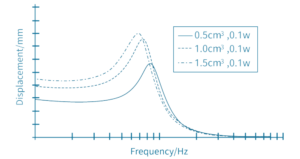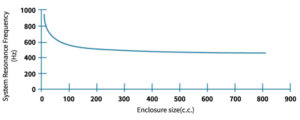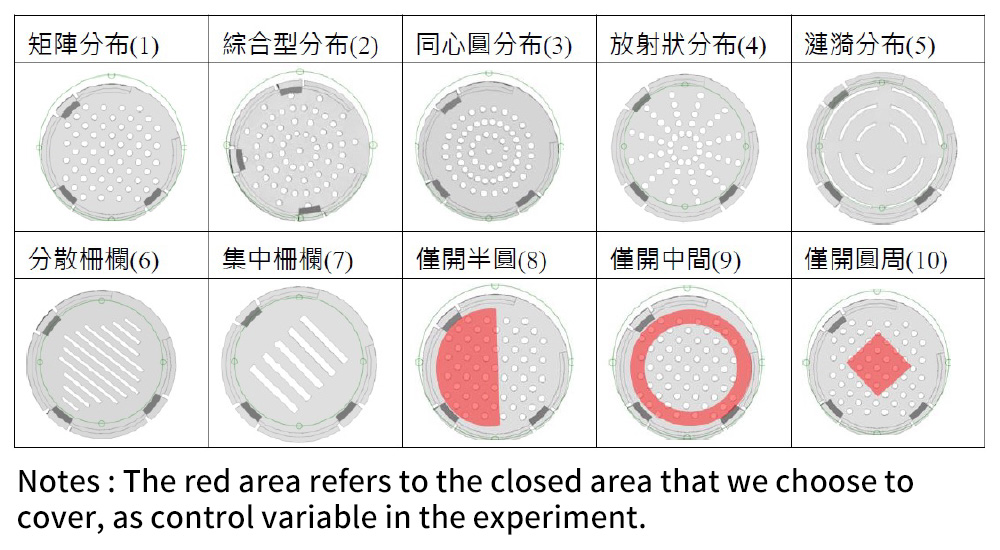Mechanical Integration
Speaker

The customer’s product will include an acoustic cavity where the speaker is installed. The space in front of the speaker is called the front cavity, and the space behind it is called the rear cavity. Typically, the volume of the rear cavity affects the low-frequency performance, while the volume of the front cavity influences high-frequency performance. The design of the front and rear cavities is crucial to the acoustic system, as the frequency response curve is influenced by the volume and even the geometry of the cavities.
Speaker cavity design involves five aspects: the front cavity, rear cavity, sound outlet, dustproof mesh, and sealing. Each aspect has its specific function. The typical structure of an acoustic cavity is shown in the diagram on the right.
1. Rear Cavity
- Restrict the propagation path of sound behind the speaker to prevent mid- and low-frequency sounds from interfering with sounds in the front, avoiding the phenomenon of acoustic short circuit. This enhances the mid- and low-frequency response, making the low frequencies richer and fuller.
- The larger the rear cavity, the lower the system’s overall low-frequency extension. However, volume increase has a saturation effect; once it exceeds a certain volume, further low-frequency improvements become minimal. For example, with a 36mm diameter speaker from AATC, if the rear cavity volume exceeds 40-60 c.c., the product’s low-frequency resonance approaches approximately 500 Hz.
- If the rear cavity is inadvertently designed into certain geometrical shapes, it may create standing waves, causing unwanted resonance at certain frequencies. To avoid standing waves in the rear cavity, it is recommended to avoid overly symmetrical designs or narrow and elongated cavity shapes.
2. Front Cavity
- The front cavity limits the high-frequency extension of the product.The advantage is that it can reduce some high-frequency noise, such as frequencies above 10kHz. However, the drawback is that it also limits the mid-to-high-frequency performance of the product, potentially causing acoustic resonance at cutoff frequencies between 6–10kHz, leading to uneven frequency responses.
- The front cavity should be as small as possible. If the front cavity is too large, it can easily lower the high-frequency cutoff, reducing the bandwidth of the mid-to-high frequencies. In addition to keeping the cavity small, the opening area of the front cavity should also be as large as possible. If there is a duct in the front cavity, the duct should be as short as possible. The opening area and the front cavity must maintain a certain ratio; the larger the cavity, the larger the opening area needs to be.
The front cavity must at least accommodate enough space for diaphragm movement, to prevent the speaker’s excessive amplitude from causing the diaphragm to strike the product casing, resulting in interference and noise. AATC can recommend different front cavity distances based on various speaker units.
Speaker amplitude (XD):
Parameter egstands for input voltage, VAS is equivalent compliance, ρ0 is air density, c is sound of spee, SD is effective diaphragm area, ωs equals to 2πfs which is resonant angular frequency, QES is electrical Q factor, s is the variable of angular frequency, while QTS is the total Q factor.


The Q factor of a speaker (Q, short for Quality) primarily refers to the total quality factor, QTS. The total quality factor is the reciprocal of the parallel combination of the electrical quality factor (QES) and the mechanical quality factor (QMS): .Based on
, the larger the QTS, the larger the excursion, XD. The effect is most prominent when , which means the excursion reaches its maximum when s/ωs=1. Other factors like the input voltage, eg, and the coil DC resistance, RE, is positively related to excursion. With regard to SD, as this value gets bigger, it means that the same force is distributed on more area, reducing the displacement per area. Furthermore, VAS is the equivalent compliance. It expresses the volume of air that when compressed to one cubic meter (or any other volume unit) exerts the same force as the compliance (Cms) of the suspension in a particular speaker. By definition, , while Cms is the softness of the surround and spider system. We observe that the softer this surround and spider system is, the more compressibility of the air, hence the more room and flexibility for the diaphragm.
It shows that the diaphragm displacement is closely related to the performance factors of an acoustic system.
- The higher the input voltage, the larger the displacement
- The softness of the diaphragm, surround and spider is negatively related to displacement
- The smaller the enclosure, the smaller the displacement
- The larger the DC resistance, the more energy is dissipated on the coil, hence the less driving energy and the less the displacement.
3. Sound Hole
- The back volume encompasses the back of the speaker and prevents the back sound wave from traveling to the front. When the sound from the back, often anti-phase to the front, leaks to the front, it may cause acoustic short circuit. This describes the back soundwave cancelling out the front waves, severely decreasing the front sound pressure level. By containing soundwaves in the back volume, back enclosure designs can enhance mid to lower frequency performance.
- The larger the back volume, the lower the cutoff frequency can extend. However, diminishing return will occur as the volume continues to rise. That is, one cannot endlessly decrease resonant frequency just by increasing the volume to, say infinity. The following example shows the frequency calculation of a phi 36mm speaker that AATC produces. From it we observe that as we approach 40 to 60 c.c. in terms of volume, we seem to approach a minimum point of 500hz resonant frequency.
- The back enclosure might show signs of standing wave if it is designed improperly. Standing waves might cause resonance vibration at certain frequencies, which give rise to noise. To avoid it, it’s recommended to design asymmetrical geometry and the space shouldn’t be too narrow or long.
4. Airtightness
Absolute airtightness must be achieved in the enclosure, ensuring no air flows between the front and back volume. If air flows from the back to the front, then it might interfere and cancel out the front sound waves, reducing the sound pressure. The same rule applies to 3D printing and prototyping as well. We seal small gaps in the assembly often with silicon or clay.
5. Mesh
Mesh prevents dust from dropping in the back of the speaker, which often consists of a basket with some holes used for pressure equalization and heat dissipation. Another use for mesh is to tune the frequency response of the speaker driver. Each kind of mesh varies in acoustic resistance, and this can help create different types of response. For example, use the mesh to damp a certain peak in the response or distortion curve. It’s the combination of mesh number, thickness and material and so on that impacts the tuning.
Receivers and earphone drivers
- The front and back venting holes of an earphone functions as pressure equalization devices. There are several benefits for venting and pressure equalization. First, if venting didn’t exist, there would be dramatic pressure change in the ear when the earphone was being taken on and off. This would create discomfort to the user as he or she will hear massive “pop” sounds and their eardrum will be sucked and pushed out rapidly. Second, equalization protects the driver diaphragm from being pulled and pushed forcefully, and this avoids diaphragm damage. Third, the venting mechanism can also be used to flush out and attenuate excessive bass frequency energy, which might sound muddy. Fourth, the venting hole allows internal body noise to flow out: if there weren’t venting holes, the rubbing and pulsing noise in the body would be trapped in the ear canal, coloring the earphone playback signal.
- The larger the back volume, the stronger the bass frequency. On the other hand, the front volume affects the higher cutoff frequency.
- There could be mesh on the venting holes, which functions as tuning device.
- At most times, the appearance of an earphone will first be designed thanks to ergonomics studies. The industrial design must fit perfectly and comfortably to the geometry of the human ear. The contacting points include housing and sponge and silicon cushion material, all vital to thermal, acoustic and industrial design. After the structure and material is decided, then we will start to choose the appropriate drivers and design internal chambers.
MIC
- When it comes to ECM, the component’s sound port should be as near the product’s housing (sound hole) as possible, as this simplifies mechanical design on gaskets, rubber holders and sound tubes. Terminations of ECMs are usually wires plus connectors, which allows mic placements much further away from the main PCB. This is beneficial because the component should get as close to the case surface as possible, eliminating any obstacles that might block the receiving sound path.
- The ECM’s sound port should be far away from unrelated sound sources, to avoid noise interference. This sound insulation is critical in applications such as noise reduction and Acoustic Echo Cancellation (AEC).
- The length of the sound tube should be minimized, to raise the high cutoff frequency, extending the bandwidth. Furthermore, the diameter of the tube should be maximized, also beneficial to higher cutoff frequency.
- The sound tube tends to enhance the on-axis sound, while attenuating sound reception off-axis.
- The front of the ECM is covered with mesh, to achieve higher Ingress Protection ratings. Regular mesh count is 500 and air permeability is at least 30%. Adding the mesh would only decrease sensitivity by 0.5dB SPL to 1dB SPL, which is negligible. Moreover, the mesh only affects higher frequencies but not mid to lower frequencies.
- There shouldn’t be any air leakage on the side of the sound tube. If there was, then some echo and noise would travel through the little gaps and cause distortion. To ensure perfect sealing between the sound ports and sound tubes, the component is often placed in a rubber holder. The rubber holder, fairly elastic, expands in the air gap and also cushions against any unwanted vibration.
- In case of microphone arrays, one should first decide where the microphones should be placed, after considering the ID restrictions. After the placement and configuration is finalized, we then input the microphone parameters, distance and array geometry into the array algorithm.
- If not interested in a flat tube, one can always resort to a tube of a funnel shape. The bottom neck of the funnel converges, thus enhancing the incoming sound signal. The opposite shape of a funnel is the shape of a pear. That is, a narrow sound inlet leads to large chamber. We should avoid this shape as this decreases the resonant frequency, also adding echo and noise due to the Helmholtz effect. One can imagine breathing into a bottle the shape of a pear, and recall hearing some high-pitched sound. This kind of sound will color the original signal.
- MEMS mic
- Top port MEMS mic
- The opening on the housing should be equal to or larger than the rubber holder opening. And the rubber holder opening should be equal or larger than the sound port of the MEMS mic. This implies a sound inlet path the shape of a funnel as mentioned before. Longer sound tube has a negative effect on cutoff frequencies so we should refrain from extending the tube for more than a total of 4 to 7mm. The shorter the tube, the better.
- Bottom port MEMS mic
- Bottom port MEMS mic is situated on a PCB and receives sound beneath the PCB. This means that the mic usually sits “upside down” to allow sound inlet, because the sound hole is at its bottom. As a rule of thumb, the overall device should not exceed 4 to 7mm in height. The shorter the tube, the better.




